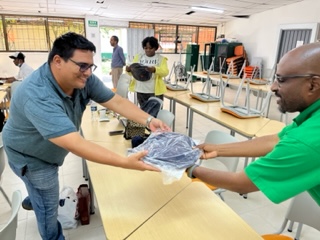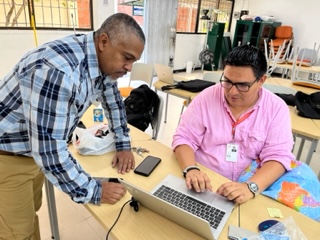Food security is essential to all people, and in times of economic inflation or pandemic isolation can best be ensured by providing and consuming highly nutritious grains, such as pulse legumes (beans and peas) mixed with other sources of calories and proteins. A CEIED/CEGFSD sponsored project in the Southeastern U.S. and Colombia, South America is evaluating cowpeas as one of these legumes. In addition, the PIs held a workshop at Agro Servicio Nacional de Aprendizaje (Agro SENA), a teaching campus in Buga, Valle de Cauca. Cowpeas are also known as black eyed, crowder, purple hulled or southern peas in English or frijoles caupi in Spanish.

The goal of this project is to determine nutritional quality of cowpea and adaptation to the Latin America and North America’s growing conditions through both societal predictions and food analysis. Geographic Information System (GIS) is a key to evaluating the adaptation potential and consumer needs for nutritious cowpea, especially when trying to increase the consumption of this healthy legume in the African-American and Afro-Colombian communities.
Due to COVID -19 waves and election concerns in Colombia, a limited number of faculty (three) and one Tennessee State University (TSU) graduate student, Ms. Maia Payne, traveled to Colombia in June 2022 to implement the activities of the project. The professors who traveled were Dr. Matthew Blair (PI – TSU), Dr. Reginald Archer (GIS specialist – TSU), and Dr. Noel Estwick (GIS specialist – Prairie View A&M University (PVAMU)). In addition, Ms. Karen Lee (Extension – TSU) was able to attend virtually as much of the workshop was streamed on MS Teams app. CEGFSD leadership, Dr. Stephan Tubene and cluster leader, Dr. Marikis Alvarez represented the Center of Excellence with virtual attendance. The in-country hosts were Ing. Mauricio Rojas, Ing. Norbey Tilmans and Ing. Hector Fabio Espinoza, all instructors in Servicio Nacional de Aprendizaje (SENA), the largest technical post-secondary program in all of Colombia. Dr. Blair provided translation Spanish to English and vice versa throughout and while on field trips as well. A memorandum of understanding with SENA was also discussed with the sub-director.
Agro SENA was a great host for the US visitors to Colombia because of their tradition of training multi-age groups from many diverse communities and because of the practical skills they teach in agricultural production, farm entrepreneurship, food industrialization and precision agriculture to their 3, 6, 9, 12 and 24 month certificate and degree program students. The GIS workshop we held centered on training on use of Garmin GPS units and data analysis with the latest Arc-GIS products that are online, with 4 instructors, 2 administrators and 2 technology students attending in person and up to 30 people attending virtually, along with the 4 North American participants and 1 representative of Agrosavia, the National Agricultural Research program of Colombia.

Within the AgroSENA campus in Buga we were able to see advanced labs for bread making, candy fabrication, dairy value-added products, food safety, meat processing, microbrewing and wine making. Tissue culture facilities, screen houses and farm fields are extensive allowing for bean and cowpea production. Tours of advanced GIS and UAV (drone) applications in sugarcane production were included in the agenda as cowpeas have been introduced as a nitrogen fixing intercrop for the premier Colombian product. Various black-eyed, cream, dark buff, red and tan colored cowpeas adapt well to conditions in Valle de Cauca region, where the Afro-population is high. Census estimates indicate that up to half of the inhabitants of Cali and adjacent municipios or departments have some Black and Indigenous ancestry. Cowpeas have a promising future for farming systems in the region based on their heat tolerance, adaptation to climate change and easy processing into multiple dishes. All together, the weeklong workshop opened a lot of eyes to the skill sets, environmental conditions and cultural characteristics found in AgroSENA and the region of Colombia visited with lively discussions on how to expand the impact of our project further.

